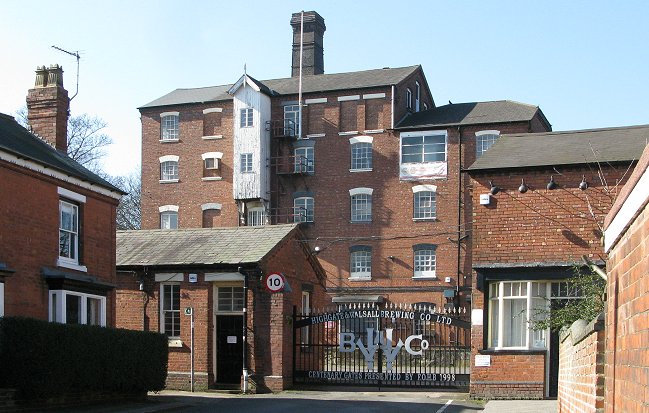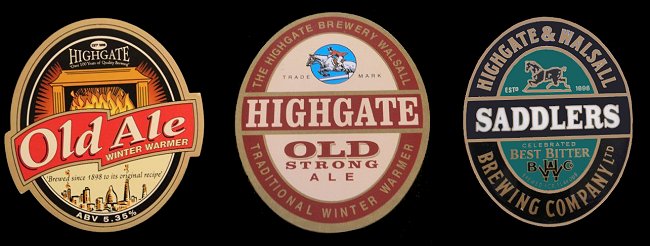|
One of Walsall’s hidden gems is the old
Highgate Brewery building in Sandymount Road, which was
Grade II Listed on 31st July, 1986.
The brewery was built between 1895 and
1898 by James A. Fletcher whose father ran Fletcher
Brothers, a long established wine and spirit merchants in
Ablewell Street. The location in Sandymount Road was chosen
because of a supply of pure brewing water, rich in iron,
from a bore hole at the end of the road. The brewing
business was registered as the Highgate-Walsall Brewery
Company Limited in 1898, and brewing began on 1st July,
1899 to supply the ten public
houses that were owned by Fletcher Brothers. The first two
employees were Fred Broadstock the brewer, and Bill Jones
the representative and drayman. |
 Highgate Brewery.
Highgate Brewery.
|
The five storey brewery made the best possible use of gravity by
allowing the various constituents to flow from process
to process, from the top floor downwards. Production was
originally aided by a steam engine, mounted on the
ground floor, which drove much of the machinery
including the malt mill. It remained in use until the
1920s when an electric motor took over.
In the first part of the twentieth
century, Highgate Brewery acquired other breweries, and
transferred their business to Sandymount Road. The first
two were small concerns at local pubs, the first being
at the Oak Inn, in Green Lane, acquired in
1903, followed by the Royal Exchange, acquired in
1904. During the First World War two other breweries
followed. They were Yardley and Ingram’s at Bloxwich,
and Town Brewery, in Short Acre Street, Walsall which
had been run since 1901 by Bolton-born brewer, John
Lord.
In 1914 Agnes Mountfield became
Highfield’s head brewer. She is believed to have been
the first female head brewer in the country. |

Another view of the brewery.
 |
A |
Hot water tank (liquor tank). |
| B |
Liquor treatment plant. |
| C |
Mashing liquor tank which stores the
treated liquor. |
| D |
Malt hopper. |
| E |
Malt screen and the grist mill which
cracks the malt and breaks up the starch. |
| F |
Grist case which feeds the crushed malt
into the mash tun. |
| G |
Mash tun where the grist and liquor are
mixed and heated to produce wort. |
| H |
Underjack which regulates the wort from
the mash tun and feeds it into the copper. |
| I |
Sugar storage tank. |
| J |
Copper where the wort is mixed with
hops and sugar, and boiled. |
| K |
Hopback where the spent hops are
removed, then sold for agricultural use. |
| L |
Jackback a storage tank for the 'brew'
from the copper, and a 'brew' pump. |
| M |
Storage tank for the cooler. |
| N |
Cooler or paraflow which cools the
'brew'. |
| O |
Fermenting Vessel where yeast is added
and fermentation takes place. |
| P |
Cooler or paraflow which cools the
beer. |
| Q |
Racker where the beer is barrelled, and
finings are added. |
| R |
Yeast tank where the used yeast is
stored. |
| S |
Yeast press where the yeast is pressed
before going into store. |
|
In the early 1920s a bottling plant
opened at Highgate, and the company began producing a
range of bottled wines, spirits, and beers, including
pale, mild, and old ales. Guinness was also bottled for
resale in the company’s pubs.
Throughout the years the brewing
plant was frequently improved and updated. The surviving
fermenting vessels date from 1905 to 1962, the malt
hopper dates from 1920, the belt-driven malt crusher
came from Dresden in Germany in 1922, the hot loquor
tanks were purchased in 1930, the wort receiver is from
1948, the coppers date from 1952 to 1957, the kickback
from 1953, the hopback from 1955, and the paraflow, and
fermenting vessels from 1970.
In 1924 James A. Fletcher and John
Lord formed Walsall Breweries Proprietory Limited to
take over the business of Arthur Beebee Limited, based
at Malt Shovel Brewery, 130 Sandwell Street, Walsall,
and its eleven public houses. Three years later saw the
end of Highgate’s horse-drawn drays. From 1927
deliveries were exclusively made by motor vehicles. |
 ~ ~
The magnificent entrance gates.
|
Take Over
The business continued to grow. By
1939 the
brewery owned over fifty public houses, produced 50,000
barrels of beer per year, and employed sixty five staff. Around that time the brewery entered
negotiations with Mitchells & Butlers of Cape Hill,
Smethwick, who
were interested in purchasing the business. On 22nd
July, 1939 when negotiations had been completed,
Mitchells and Butlers purchased the whole concern,
including Highgate Brewery, Walsall Breweries Proprietory Limited, and all of the company’s public
houses.
Initially Mitchells and Butlers had
decided to end production at Walsall, which was their
usual practice for any brewery they acquired. The intention was to turn it into a depot, but
World War 2 intervened. At the onset of war, every
brewery received an allowance for malt and hops, which
were rationed. In order to draw the ration, and to
satisfy the great demand for Highgate dark mild ale,
Mitchells and Butlers took the unprecedented decision to
continue brewing at Highgate.
After the take-over, the bottling
plant closed, and the product range was limited to Mild
Ale, and Old Ale (produced between September and
February, and bottled at Cape Hill), the last bitter
being produced in 1940. During the war the Auxiliary
Fire Service was stationed at the brewery, and company’s
mild ale continued to be extremely popular. |
|

A Highgate beer mat. |
The next major change took place
after 1960 when William Butler & Company Limited of
Springfield Brewery, Wolverhampton became part of
Mitchells & Butlers.
The distribution side of the
business at Walsall was transferred to Springfield
Brewery, and the production of Highgate Old Ale ceased.
Mitchells & Butlers replaced it
with Butler’s Old
Ale, brewed at Springfield.
In 1961 Mitchells & Butlers merged
with Bass, Ratcliff & Gretton to form Bass, Mitchells &
Butlers Limited. |
| By the early 1980s, lighter bitter ales, and lager
had become more fashionable, but Highgate still managed
to produce around 100,000 barrels of mild each year,
with about thirty staff. In 1982 the number of staff was
reduced to twenty two, and further reduced in 1985 to
twelve. It became Bass, Mitchells & Butlers Limited’s
smallest brewery.
Turbulent Times
Late in 1995, Bass, Mitchells &
Butlers Limited decided to close Highgate Brewery. Its
fate seemed to be sealed, but on the eve of closure it
was saved by a management buyout, led by the group’s
Marketing Manager, Steve Nuttall, and the Brewing
Director, Neil Bain. They acquired the brewery at a cost
of £600,000 and its future seemed secure. |
| In 2000, Bass announced the end of its beer
production and the sale of its breweries, including
Highgate Brewery which was purchased by Aston Manor
Brewery, based in Aston, Birmingham.
The new owner, a large producer of canned beers and
ciders, purchased it to produce canned beer for
supermarkets.
Two years later the company decided to revive the
once-famous Davenports brand which disappeared in 1986
after the closure of Davenports Brewery.
This resulted in a new range of Davenports’ beers,
which were brewed at Highgate. |

Another Highgate beer mat. |
|
The brewery seemed to be in a good
position with a bright future ahead. It had nine public
houses which it supplied with its range of 30 cask ales,
including Highgate Dark Mild, and produced a range of
bottled beers including Old Ember Ale, England's Ale and
the popular regional brew Davenports, which sold
well in the large supermarkets, and off-licences. The
brewery had an annual turnover of around £5.5 million.
In July 2007 Aston Manor Brewery
sold Highgate Brewery to the pub company Global Star
which had over one hundred public houses. Global Star
planned to supply Highgate beers to all of its public
houses. This would increase production at the brewery,
which had been running at half of its production
capacity.
£0.5 million was to be invested at Highgate,
which would still continue to supply beers to Aston
Manor. A bottling plant was to be built on the site, and
the three original wells would be brought back into use, to
remove the brewery's dependence on mains water.
Sadly the new venture was
short-lived. In September 2009, the company, now called
Highgate & Davenports, went into administration with
reported tax debts of more than £1 million. The brewery
continued to operate and was soon sold by the
administrators for £80,000 to two property developers,
Simon Toon and David Lindol. Unfortunately on 14th June,
2010 it went into voluntary liquidation and closed, with
the loss of twenty jobs. |

Throughout its life, the brewery has owned many Walsall
pubs at one time or another, including the following:
| |
|
|
|
|
| Pub |
Location |
|
Pub |
Location |
| Bakers Arms |
Caldmore |
|
Old Still |
Digbeth |
| Brewery Stores |
High Street |
|
Paul Pry |
New Street |
| Brown Lion |
Pleck |
|
Priory |
Park Street |
| Bulls Head |
Bloxwich |
|
Rose & Crown |
Birchills |
| Criterion |
Green Lane |
|
Royal Exchange |
Bloxwich |
| Curriers Arms |
Day Street |
|
Royal Exchange |
Ryecroft |
| Durham Ox |
Park Street |
|
Royal Oak |
Palfrey |
| Dusty Miller |
North Street |
|
Seven Stars |
Stafford Street |
| Fox |
Stafford Street |
|
Tavern In The Town |
Bradford Street |
| Globe |
Bridgeman Street |
|
Teddeslay Arms |
Teddesley Street |
| Golden Lion |
Birchills |
|
Three Crowns |
Wood End |
| Hatherton Arms |
Lichfield Street |
|
Turks Head |
Digbeth |
| Littleton Arms |
Hatherton Street |
|
Union |
Bath Street |
| Malt Shovel |
Lower Rushall Street |
|
Watering Trough |
Ablewell Street |
| Oak Inn |
Green Lane |
|
|
|
| |
|
|
|
|
|
 |
Return to
the
previous page |
|

